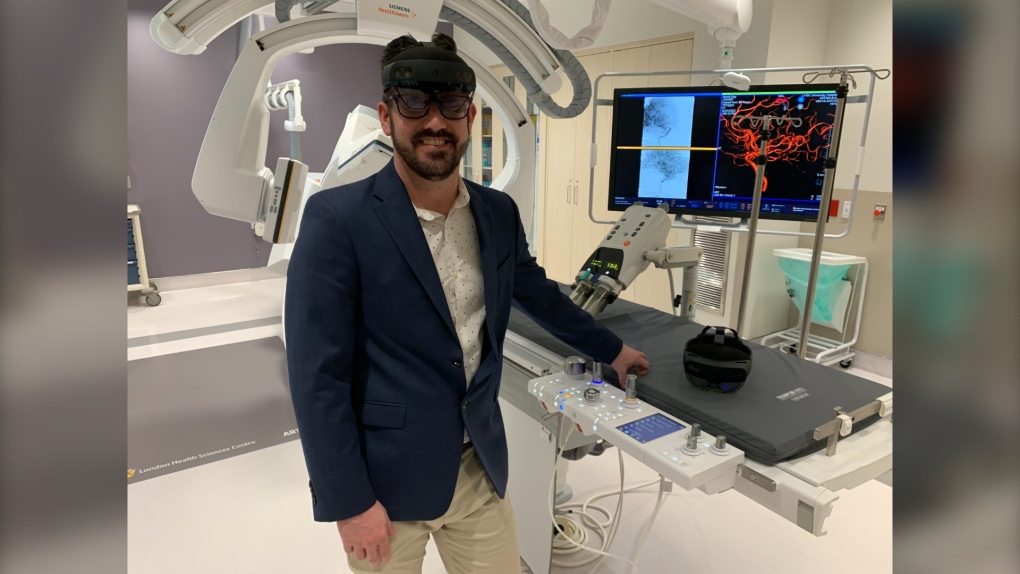'Like you’ve stepped a little bit into the future': Mixed reality technology being used to treat patients at LHSC
A new mixed reality research project is taking x-rays to a whole new level at London Health Sciences Centre.
“The HoloLens technology allows those virtual screens to be placed wherever the physician wants. Kind of maintains the contact between the physician and the patient,” explained Jonathan Collier, an interventional radiology technologist.
Wearing a special mixed reality headset, Collier looks at and manipulates a volume rendered virtual model, or hologram, of an anatomized brain aneurysm. He can manipulate the hologram and move it into place exactly where he wants, allowing him to perform a minimally invasive procedure with great accuracy.
The best part for the operating physician, is that they no longer have to look at a traditional monitor off to the side or in another part of the room.
Division Lead for Diagnostic and Interventional Neuroradiology at LHSC Dr. Sachin Pandey was among the first to use the Microsoft HoloLens.
He said patients are duly impressed.
“Oh well you can imagine, there is a certain kind of wow factor to it right, you feel like you’ve stepped a little bit into the future,” he explained.
 Interventional radiology technologist Jonathan Collier wears a mixed reality headset in London, Ont. on March 7, 2024. (Bryan Bicknell/CTV News London)
Interventional radiology technologist Jonathan Collier wears a mixed reality headset in London, Ont. on March 7, 2024. (Bryan Bicknell/CTV News London)
“The benefit of the patient, in theory, is they get the undivided attention physically and mentally of their doctor. In fact, that talking and being responsive to the patient is a big part of what makes it a tolerable experience for people. So again. Any barrier you can remove from the patient helps do that,” he added.
The software for HoloLens was developed by Dr. David Hocking, a diagnostic and interventional radiologist at LHSC. He said he saw a way to achieve better patient outcomes.
“The closer you can bring your visual field to where you’re working, the better your accuracy. And this allows us to put the screen front and centre with the patient,” he said.
The mixed reality research project is supported by more than $1 million in funding from the London Health Sciences Foundation and the Children’s Health Foundation.
“This is a pilot project so we are right at the baby steps of where I think this can be generalized,” said Pandey.
CTVNews.ca Top Stories

Trudeau to announce temporary GST relief on select items heading into holidays
Prime Minister Justin Trudeau will announce a two-month GST relief on select items heading into holidays to address affordability issues, sources confirm to CTV News.
'Ding-dong-ditch' prank leads to kidnapping, assault charges for Que. couple
A Saint-Sauveur couple was back in court on Wednesday, accused of attacking a teenager over a prank.
Border agency detained dozens of 'forced labour' cargo shipments. Now it's being sued
Canada's border agency says it has detained about 50 shipments of cargo over suspicions they were products of forced labour under rules introduced in 2020 — but only one was eventually determined to be in breach of the ban.
'It changed my life': Montreal-area woman learning how to walk after being hit by stray bullet
A 24-year-old woman is learning how to walk again after being shot while lying in her bed in Repentigny, Que.
BREAKING ICC issues arrest warrants for Israel's Netanyahu, Gallant and Hamas leader
Judges at the International Criminal Court have issued arrest warrants for Israeli Prime Minister Benjamin Netanyahu and his former defence chief, as well as a Hamas leader, Ibrahim Al-Masri, for alleged war crimes and crimes against humanity.
Genetic evidence backs up COVID-19 origin theory that pandemic started in seafood market
A group of researchers say they have more evidence to suggest the COVID-19 pandemic started in a Chinese seafood market where it spread from infected animals to humans. The evidence is laid out in a recent study published in Cell, a scientific journal, nearly five years after the first known COVID-19 outbreak.
Donald Trump picks former U.S. congressman Pete Hoekstra as ambassador to Canada
U.S. president-elect Donald Trump has nominated former diplomat and U.S. congressman Pete Hoekstra to be the American ambassador to Canada.
REVIEW 'Gladiator II' review: Come see a man fight a monkey; stay for Denzel's devious villain
CTV film critic Richard Crouse says the follow-up to Best Picture Oscar winner 'Gladiator' is long on spectacle, but short on soul.
Alabama to use nitrogen gas to execute man for 1994 slaying of hitchhiker
An Alabama prisoner convicted of the 1994 murder of a female hitchhiker is slated Thursday to become the third person executed by nitrogen gas.


































